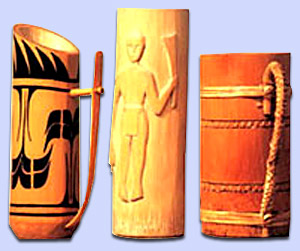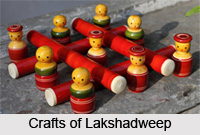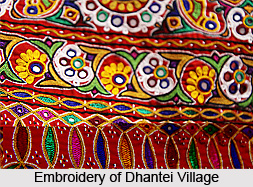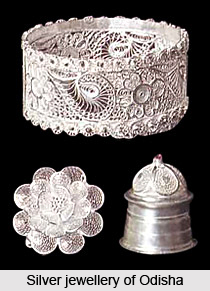 Metal craft of Orissa can be featured with the socio cultural aspect of the state in association with the tradition. The shrines and the temples are the examples of rich cultural heritage of the state with standard materials.
Metal craft of Orissa can be featured with the socio cultural aspect of the state in association with the tradition. The shrines and the temples are the examples of rich cultural heritage of the state with standard materials.
The metal craft of Orissa includes the usage of metals like Brass and Bell metals and the people of Kansari community mainly create different items out of them. Castings of brass items are practiced by the people of Ganjam. The motifs used in the decorative pieces are mainly inspired from the folk culture of Orissa. The artisans use an alloy of copper and zinc and of copper and tin to give shape to different items. Apart from the usage of brass and bell metals the artisans of Orissa are adept at creating jewelleries and items with silver and gold. Cuttack is famous in the entire world for the unique and delicate craft of `tarkashi` or well known as the silver filigree work. This art of creating items is considered one of the intricate works by the artisans who create splendid jewelleries with a touch of tradition. According to history, the filigree work or `tarkashi` of Cuttack was once sought after by royal households and merchants from far and wide.
The metal craft of Orissa has been flourishing at Puri, which is the abode of skilled craftsmen who specialise in minute metal work. Moreover, places such as Behrampur and Belguntha (in Ganjam district), Tarva (Bolangir district), Chandanpur, Phulbani, and Kantilo are well known for their specialization in producing a variety of brass and bell metal craft objects, which exhibit extraordinary craftsmanship. In Tarva, the craftsmen fashion beautiful utilitarian and decorative objects such as plates, ashtrays and bells out of white metal. A particular variety of metal craft known as `dhokra` is practiced by the `sithulias` who use scraps of metals to make the `dhokra` castings.
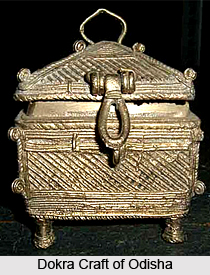 The motifs of the `dhokra` castings basically contain the elephant, dhokra metalware items-boxes, lamps, and figures of deities-by the cire perdue or lost wax method. One can also find the images of Lord Ganesha and Goddess Durga cast on the metal crafts. . Moreover, not only the deities but the items of worship like `Ghanta` or `ghanti` which means the bell which is indispensable for all ritual worships, particularly during `aarati` and offering of food to god. During the `Rath Yatra` or Car Festival, hundreds of the gongs are beaten rhythmically by the devotees and priests in frenzied ecstasy as the divine chariots are pulled forward by the thronging millions. Sometimes, the surface of the items is also engraved with various designs including floral and geometric patterns besides human and animal figures and occasionally they are also painted with enamel paints to add an effect of tradition. The items produced by the beating process are many and the designs also vary from place to place. The `Manjira` or `gini`, two circular cupped convex discs tied to strings and used for beating the rhythm and the `Ghunguroo` or ankle bells tied in the feet of dancers during the festival. Kuliana in Mayurbhanj district, Kaimatin in Keonjhar district, Sadeiberni in Dhenkanal district and Haradagaria in Puri district are well admired for their superiority in Dhokra craft.
The motifs of the `dhokra` castings basically contain the elephant, dhokra metalware items-boxes, lamps, and figures of deities-by the cire perdue or lost wax method. One can also find the images of Lord Ganesha and Goddess Durga cast on the metal crafts. . Moreover, not only the deities but the items of worship like `Ghanta` or `ghanti` which means the bell which is indispensable for all ritual worships, particularly during `aarati` and offering of food to god. During the `Rath Yatra` or Car Festival, hundreds of the gongs are beaten rhythmically by the devotees and priests in frenzied ecstasy as the divine chariots are pulled forward by the thronging millions. Sometimes, the surface of the items is also engraved with various designs including floral and geometric patterns besides human and animal figures and occasionally they are also painted with enamel paints to add an effect of tradition. The items produced by the beating process are many and the designs also vary from place to place. The `Manjira` or `gini`, two circular cupped convex discs tied to strings and used for beating the rhythm and the `Ghunguroo` or ankle bells tied in the feet of dancers during the festival. Kuliana in Mayurbhanj district, Kaimatin in Keonjhar district, Sadeiberni in Dhenkanal district and Haradagaria in Puri district are well admired for their superiority in Dhokra craft.
The metal craft of Orissa has socio-cultural links and according to the traditions of the state, the bride is presented with a set of brass and bell metal articles for starting off her new home. However, in all major temples almost invariably the moving image or the `Chalanti Pratima` of the presiding deities is made of brass. Among the major icons, the large brass image of Radha in the `Sakhigopal temple` in Puri district , images in temples in Ganjam district, Krishna, Radha, Ganesha, Gurundi Gopal and Laxmi idols are created with the brass metal. The artisans generally create items based on the motifs of human heads, kings, `Manas` or miniature replica of measures; other items include containers with lids, with or without locking devices, candle stands, ashtrays, pen stands, bowls, plates, spoons, glass, tumbler, bells, thali (plates), handi, baltis (buckets), gina (tumblers), pots and pans, ladles or `Chatu`, perforated flat cooking spoons etc. Even items like the brass fish and snakes are made by the craftsmen of Belguntha in Ganjam district.
Apart from creating household items and items for worship, the metal craft of Orissa include items that are hugely favoured for home décor. Even people who flock to the market of the state prefer to buy exquisitely designed bronze bangles and lamp stands that define exclusive style and standard of the artisans among whom some have been practicing this art form for generations.



